Tennis isn’t just about perfecting your backhand or spending hours on the court. What you eat and drink plays a huge role in your energy, focus, and how you hold up during those long, sweaty matches. Understanding tennis nutrition strategies is essential for optimizing performance. Incorporating effective tennis nutrition strategies can significantly enhance your game.
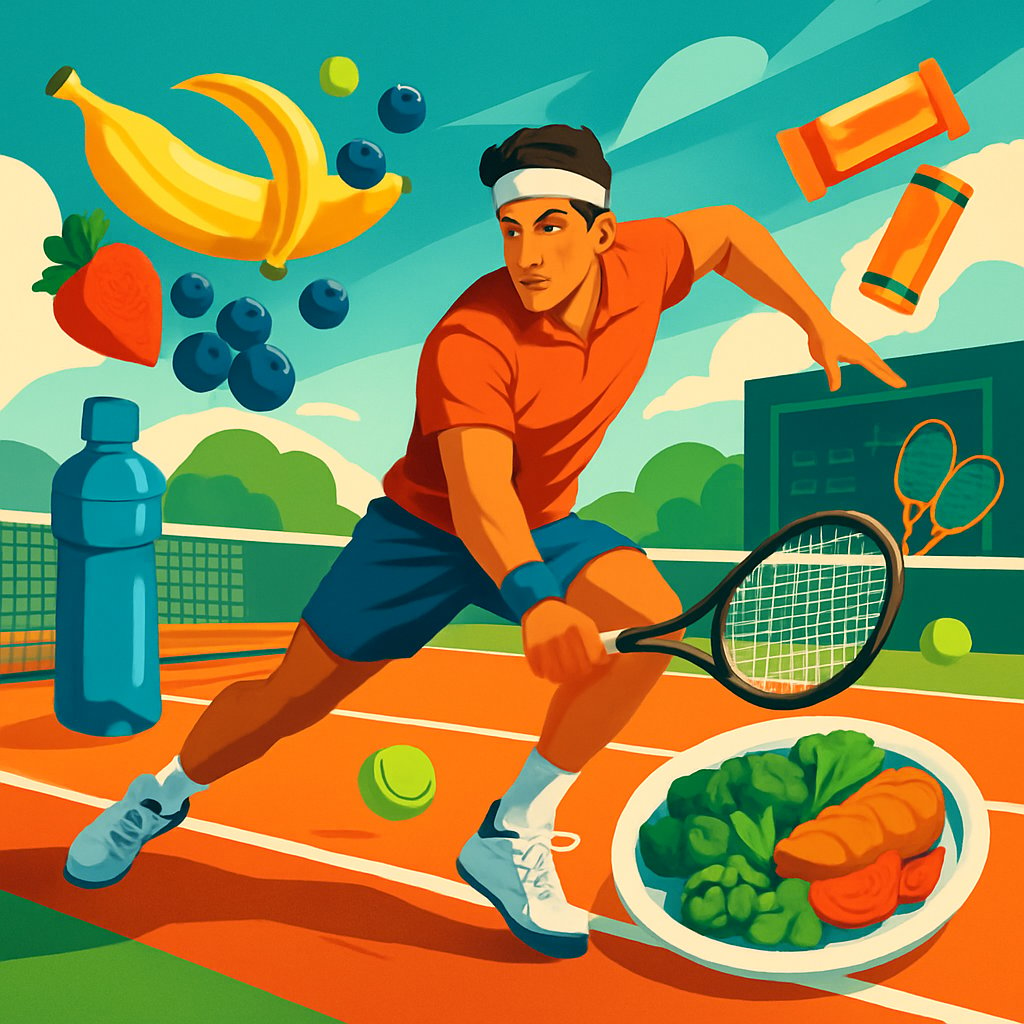
The right nutrition strategy can be the difference between maintaining your power in the final set or struggling to keep up with your opponent. Tennis demands quick bursts of energy, solid endurance, and sharp mental focus.
You’ve got to fuel your body at the right times. Otherwise, it’s just too easy to hit a wall.
Smart nutrition choices help you train harder and recover faster. Every bite and sip matters, from your pre-match meal to what you grab after the last point.
Key Takeaways
- Proper nutrition directly affects your energy, stamina, and mental focus during tennis matches.
- Timing your meals and hydration around training and matches maximizes your performance.
- Strategic eating and smart supplement choices support faster recovery and long-term development.
Core Principles of Tennis Nutrition
Tennis nutrition strategies are vital for athletes looking to improve their performance and recovery. Effective tennis nutrition strategies can directly impact your energy levels and overall success on the court.
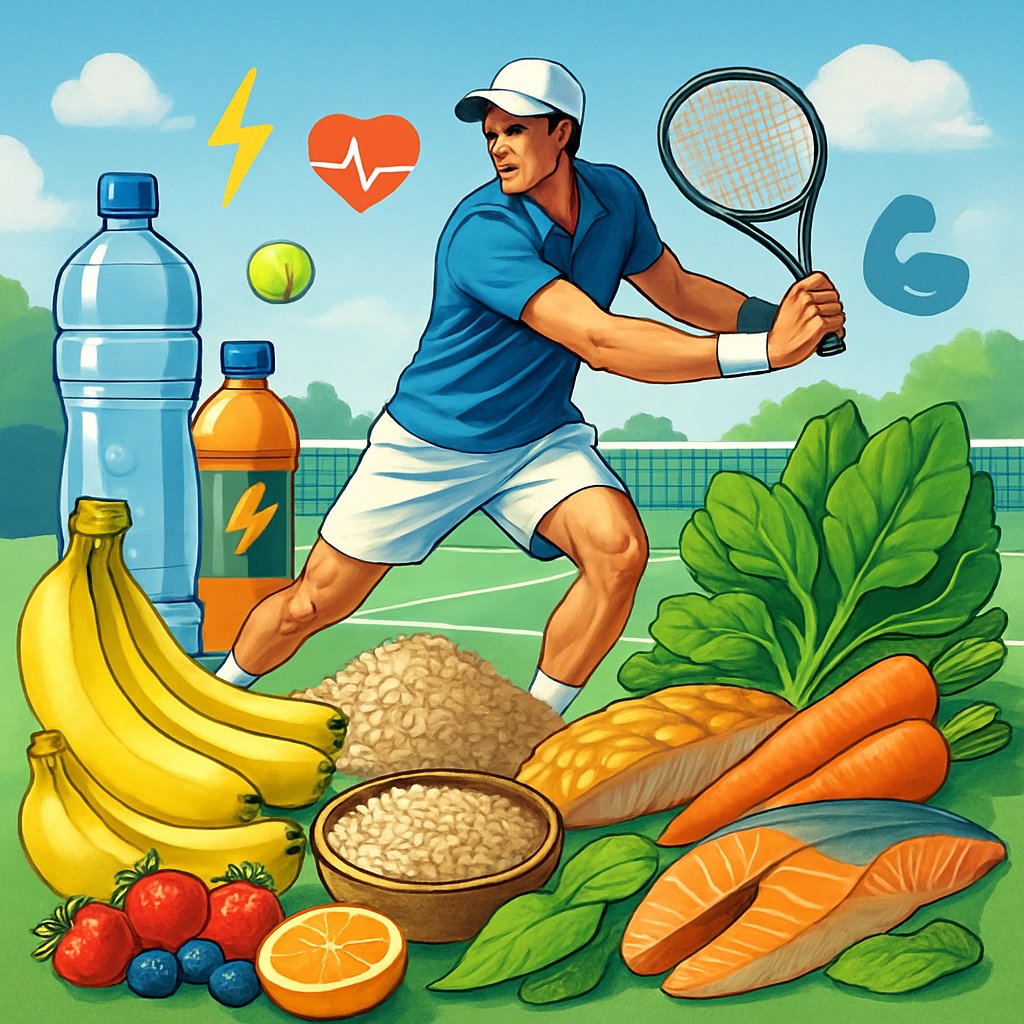
Tennis players need a good balance of carbs for energy, protein for muscle, and healthy fats for stamina. When you eat matters as much as what you eat.
Implementing tennis nutrition strategies not only fuels your body but also helps in maintaining focus during those critical moments of a match.
Integrating tennis nutrition strategies into your training routine can enhance endurance and recovery.
Consistent tennis nutrition strategies play an essential role in an athlete’s training regimen. Understanding how to balance your meals and snacks is key.
Macronutrient Needs for Tennis Players
Mastering tennis nutrition strategies enables players to maintain their optimal performance throughout tournaments and long practice sessions.
Carbohydrates are the backbone of your tennis diet. Your muscles burn carbs fast during quick sprints and rallies.
Aim for 55-60% of your daily calories from carbs. Think oatmeal, brown rice, and whole grain pasta for longer-lasting energy.
Simple carbs like bananas give you quick fuel right before or during play. They’re easy on the stomach and hit your bloodstream fast.
Protein repairs and builds muscle. You’ll want 1.2-1.7 grams per kilogram of body weight each day, spread out over your meals.
Good sources? Lean meats, fish, eggs, dairy, and legumes. Keep it varied so you don’t get bored.
Healthy fats should be 20-30% of your daily calories. They help you go the distance and absorb vitamins.
Nuts, avocados, olive oil, and fatty fish are all solid picks.
Meal Timing for Optimal Energy
Eat your main meal 3-4 hours before you play. That way, your body has time to digest and you’re not running on empty.
Go for high carbs and moderate protein in that meal. If you’re hungry an hour or two before, a banana or small energy bar is just about perfect.
Utilizing tennis nutrition strategies effectively can ensure you’re ready to perform your best when it counts the most.
By incorporating effective tennis nutrition strategies, players can ensure they are fueling their bodies correctly for optimal performance.
By integrating tennis nutrition strategies into your regimen, you can enhance your overall athletic performance.
During long matches, take in 30-60 grams of carbs each hour after the first. Sports drinks, bananas, or gels can keep you going.
After you play, eat within 30-60 minutes. Combine carbs and protein in a 3:1 or 4:1 ratio to kickstart recovery.
Role of Micronutrients in Performance
Iron delivers oxygen to your muscles and keeps fatigue at bay. Female players especially need to watch their iron.
Add foods like red meat, spinach, and fortified cereals to your meals. It’s worth it.
Calcium and vitamin D keep bones strong. Tennis is tough on your skeleton, with all the jumping and quick stops.
Dairy, leafy greens, and a bit of sunshine cover your bases. Don’t skip them.
B vitamins help turn food into usable energy. You’ll need more when training ramps up.
Understanding the role of various nutrients in tennis nutrition strategies can give you the edge over your competition.
Whole grains, lean meats, and veggies are your best bet here.
Pay attention to how different tennis nutrition strategies affect your body during training and matches.
Antioxidants (think vitamin C and E) help reduce muscle damage. Eat a rainbow of fruits and veggies to get plenty.
Pre-Match Fueling Strategies
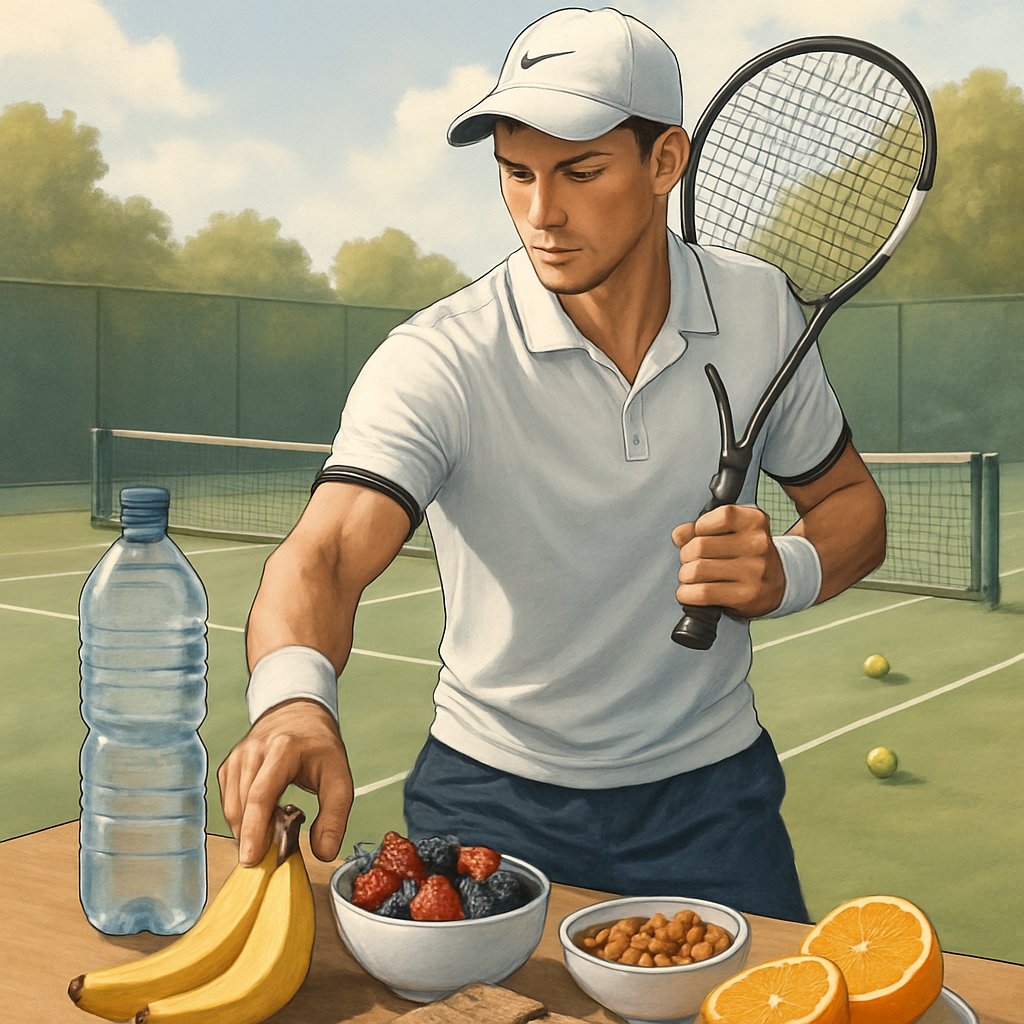
Eat balanced meals 3-4 hours before play. Hydrate throughout the day. Time your carbs to top off energy stores.
Building Effective Pre-Match Meals
Your pre-match meal? Complex carbs, lean protein, and not much fat. Keep it simple and eat 3-4 hours before you hit the court.
Some good choices:
-
- Whole grain pasta with grilled chicken and veggies
- Brown rice with fish and steamed broccoli
- Oatmeal with banana and Greek yogurt
Specializing in tennis nutrition strategies can lead to improved performance and quicker recovery times.
Skip high-fat and high-fiber foods. They’re harder to digest and can mess with your stomach mid-match.
Need a snack closer to game time? Grab a banana or a small energy bar 30-60 minutes before you play.
A well-structured approach to tennis nutrition strategies will benefit your training and match readiness.
Hydration Techniques Before Play
Start drinking water early. Don’t wait until you’re about to walk on court.
Drink 16-20 ounces of water 2-3 hours before your match. Then, have another 8 ounces about 15-30 minutes before you start.
Hydration timeline:
- Morning: Sip water regularly.
- 2-3 hours before: 16-20 ounces.
- 15-30 minutes before: 8 ounces.
Check your urine color. Light yellow? You’re good. Dark yellow? Drink more.
If you’re playing over an hour or it’s hot, sports drinks with electrolytes can help.
Experiment with different tennis nutrition strategies to find the best fit for your body and performance style.
Optimizing Carbohydrate Intake
Carbs fuel your muscles and your brain. Don’t just load up on match day—get enough in the days before, too.
Aim for 3-5 grams of carbs per pound of body weight each day. That keeps your glycogen stores full.
Go-to carbs:
- Complex: Rice, pasta, bread, potatoes
- Simple: Fruit, honey, sports drinks
Carb-load 2-3 days before big matches. Time your last carb snack 30-60 minutes before you play for a burst of energy.
In-Match Nutrition and Hydration Essentials
In-match, effective tennis nutrition strategies will keep your energy levels stable and your focus sharp.
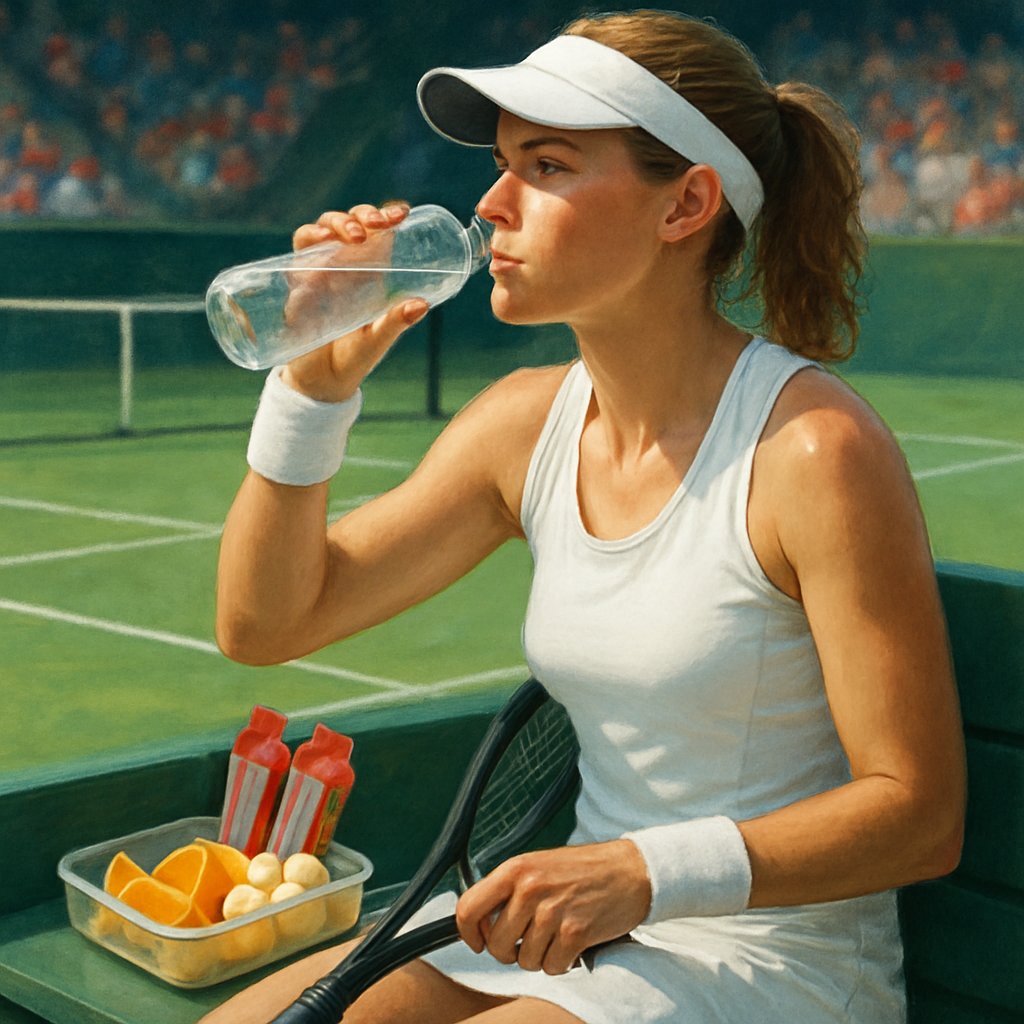
Matches can drag on for hours, so you’ve got to keep fueling and hydrating. Otherwise, your energy and focus just fizzle out.
Staying Energized During Play
You burn through energy fast during intense matches. Refuel every 60-90 minutes to stay sharp.
Best in-match energy sources:
- Bananas for quick carbs and potassium
- Energy bars with 20-30g carbs
- Sports drinks with 6-8% carbs
- Dates or dried fruit for natural sugar
Eat small bites during changeovers. Don’t wait until you’re wiped out.
Being aware of your hydration and energy needs through tennis nutrition strategies is crucial for success.
Stick to foods that digest easily. Protein, fat, or fiber can slow you down and upset your stomach mid-match.
Managing Electrolyte Balance
Sweat steals your sodium, potassium, and other electrolytes. If you don’t replace them, your muscles can cramp up.
Key electrolyte needs:
- Sodium: 200-300mg/hour
- Potassium: 150-250mg/hour
- Magnesium: 50-100mg/hour
Hot days mean you’ll lose more. Sometimes you’ll need double the usual amount if it’s really steamy out.
Electrolyte balance is another critical component of tennis nutrition strategies to prevent cramping and fatigue.
If you start cramping or feeling dizzy, you might be running low.
Choosing Sports and Electrolyte Drinks
Sports drinks give you carbs and electrolytes in one bottle. Look for 6-8% carb concentration for best absorption.
What to look for:
- 14-19g carbs per 8oz
- 110-170mg sodium per 8oz
- Not overloaded with artificial stuff
- Flavors you actually like
If a drink tastes too sweet, water it down. Your taste buds can get weird during exercise, so try different drinks at practice.
Prefer eating your carbs? Go for electrolyte drinks without sugar.
Energy gels can be a part of your tennis nutrition strategies, providing quick carbs and electrolytes during matches.
Using Energy Gels for Sustained Performance
Energy gels are handy when solid food just feels too heavy. Use them during long matches or tournaments.
How to use gels:
- One gel every 45-60 minutes
- Always chase with 4-6oz water
- Don’t wait until you’re tired
- Practice with them before using in a real match
Pick gels with 20-25g carbs and some electrolytes. Some have caffeine, but don’t overdo it or you’ll get the jitters.
Take gels at the start of games, not during points, to avoid tummy trouble.
Post-Match Recovery Nutrition
Focus on your recovery with effective tennis nutrition strategies post-match to maximize your training efforts.

After a match, you need the right nutrients within 30-60 minutes to kickstart recovery. Carbs refill your energy, and protein repairs muscle.
Immediate Nutritional Priorities
First thing after you finish? Replace lost fluids and electrolytes. Dehydration just drags out recovery.
Drink 16-24 ounces of water for every pound you lost. If you played longer than 90 minutes or sweated a lot, add an electrolyte drink.
Quick recovery picks:
-
- Sports drinks (6-8% carbs)
- Chocolate milk (3:1 carb-to-protein)
- Water with a pinch of salt
- Coconut water for natural electrolytes
Pairing protein with carbs is a fundamental aspect of tennis nutrition strategies for optimizing recovery.
Eat something within 30 minutes. Your muscles soak up nutrients better right after you finish.
Supporting Muscle Repair with Protein
Protein rebuilds muscle fibers broken down during play. Your muscles need those amino acids to recover and get stronger.
Shoot for 20-25 grams of high-quality protein after a match. That’s enough for recovery without overdoing it.
Best protein sources:
-
- Greek yogurt (15-20g per cup)
- Chicken breast (25g per 3 oz)
- Eggs (6g each)
- Protein shakes or bars
- Tuna (20g per 3 oz can)
For athletes, adhering to tennis nutrition strategies helps in maintaining energy and strength throughout the season.
Pair protein with carbs for better absorption. Carbs help shuttle protein to your muscles.
Replenishing Glycogen Stores
Your muscles burn through glycogen during matches. Refilling those stores keeps you from feeling wiped out next time you play.
Eat 1-1.5 grams of carbs per kilogram of body weight within two hours. For a 150-pound player, that’s about 70-100 grams.
Good carb choices:
-
- Bananas with peanut butter
- Whole grain toast with honey
- Oatmeal and berries
- Rice with veggies
- Sweet potatoes
Make sure your tennis nutrition strategies are tailored to your specific training needs and performance goals.
Complex carbs release energy steadily. Simple sugars are fine right after a match, but complex carbs support longer recovery.
Mix carbs and a little protein for the best glycogen boost.
Protein and Supplement Strategies
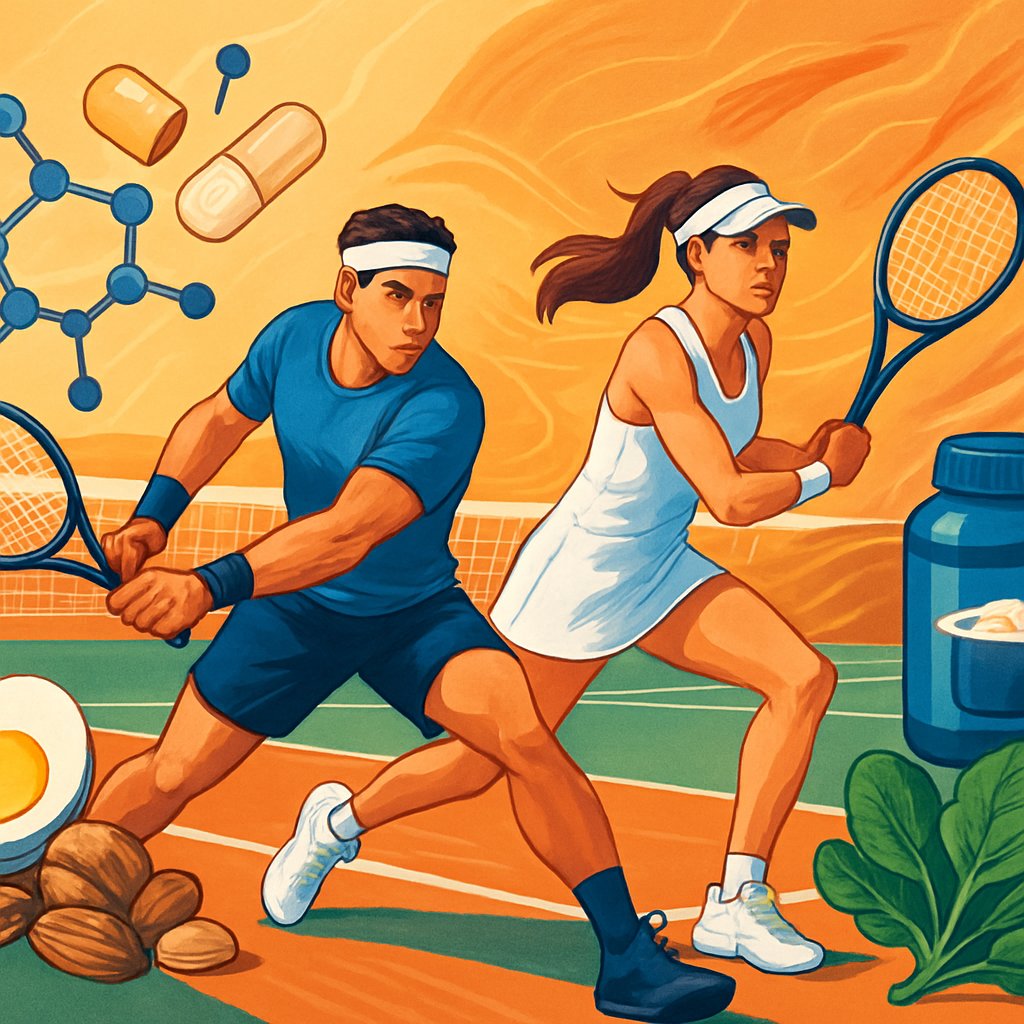
Protein is key for tennis players. It supports muscle repair and keeps you in top shape after tough training or matches.
Selecting Quality Protein Sources
The best proteins have all the amino acids your muscles crave. Lean meats, fish, eggs, and dairy are top picks.
Animal proteins give you the biggest bang for your buck. Chicken, turkey, lean beef, and fish serve up 20-30 grams per serving and digest easily.
Top animal protein sources:
-
- Chicken breast: 31g/100g
- Salmon: 25g/100g
Integrating a variety of protein sources into your tennis nutrition strategies will support muscle repair and growth.
- Greek yogurt: 20g/cup
- Eggs: 6g/egg
If you’re vegetarian, quinoa, hemp seeds, and soy products have complete amino acid profiles. Pairing rice and beans works too.
Aim for 1.2-2.0 grams of protein per kilogram of body weight daily. Spread it out over your meals for best results.
Effective Use of Whey Protein
Whey protein absorbs quickly, so it’s great for post-workout recovery. Your muscles can start using it in about 30 minutes, which helps kick off the repair process fast.
Take 20-25 grams of whey protein within half an hour after training or matches. This helps you make the most of that “anabolic window” when your muscles are primed to rebuild.
Whey works even better with some carbs. Toss a banana or a handful of berries into your shake to refuel and support recovery.
If you’re sensitive to lactose, go for whey protein isolate instead of concentrate. Isolate usually has less lactose and more protein per scoop—think 90% protein versus 70-80% in concentrate.
Balancing Protein Supplements in Training
Protein supplements should back up real food, not take its place. Whole foods give you vitamins, minerals, and fiber that powders just can’t match.
Finding the right balance in your tennis nutrition strategies is vital for sustaining energy and performance.
Supplements come in handy during tough training blocks or when you’re too busy to cook. They’re a lifesaver when you’re always on the move.
Try to time your supplements for maximum effect. Take whey after workouts, casein before bed for overnight recovery, and plant protein between meals if you need a boost.
Daily Protein Timing:
- Morning: Eggs or Greek yogurt
- Post-workout: Whey protein shake
- Meals: Lean meat, fish, or tofu
- Before bed: Casein or cottage cheese
Keep an eye on your total protein intake. Too much protein won’t boost your performance and could put extra strain on your kidneys.
Long-Term Performance and Dietary Considerations
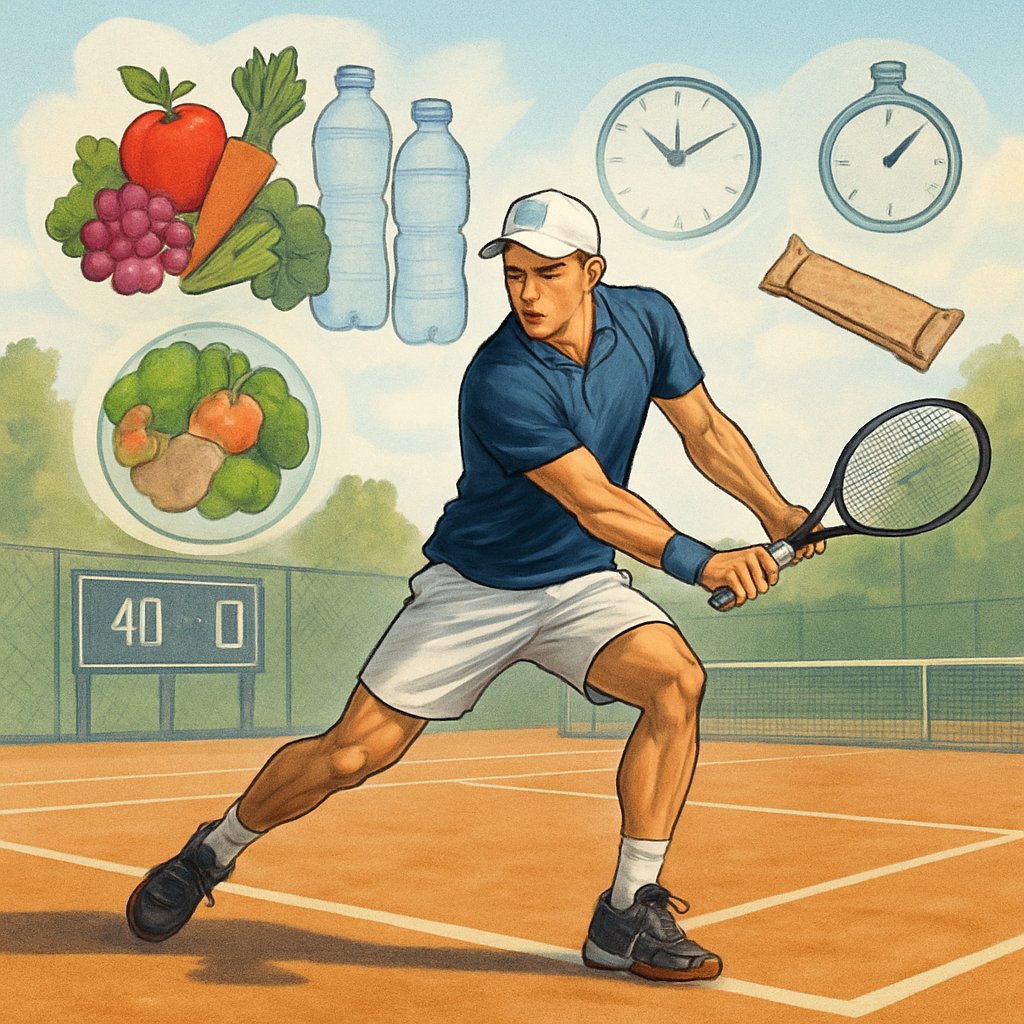
Tennis players need nutrition plans that work all year and adapt as things change. Your body type, training schedule, and goals all play a part in figuring out the foods that suit you best.
Regularly review and adjust your tennis nutrition strategies as you progress in your training and competitions.
Sustaining Peak Performance Season After Season
Tennis seasons can feel endless and tough on the body. You’ve got to keep fueling up, day in and day out, to handle months of training and matches.
Build your daily meals around these three nutrients:
- Carbohydrates for quick energy
- Protein for muscle repair and growth
- Fats for long-lasting energy
You’ll burn different amounts of energy depending on your training phase. Heavy training? You’ll need more calories than on lighter weeks.
Nutrition needs shift with the season. Pre-season, you want more protein to build strength. Once matches start, carbs become the priority for energy.
Eat with the season in mind:
-
- Off-season: Add more protein to build muscle
Incorporating seasonal variations into your tennis nutrition strategies can enhance your performance and recovery.
- Pre-season: Balance all nutrients for tough workouts
- In-season: Focus on quick energy and recovery foods
Customizing Nutrition for Individual Needs
Every tennis player is a little different. Age, size, and playing style all matter when it comes to your diet.
Think about these personal factors:
Be mindful of how your body responds to different tennis nutrition strategies and adjust accordingly.
| Factor | How It Affects Nutrition |
|---|---|
| Body size | Bigger players need more calories |
| Playing style | Power players may need more protein |
| Training hours | More hours mean more food needed |
| Age | Younger players need extra nutrients |
Your metabolism controls how fast you burn through energy. Some folks just need to eat more often to keep up.
It’s smart to work with a sports nutritionist if you can. They’ll help you figure out what actually works for you and tweak your plan as you go.
Signs your nutrition is on track:
-
- You’ve got steady energy in long matches
- You bounce back quickly after training
Track your energy levels and performance as you implement various tennis nutrition strategies.
- Your weight stays healthy
- You’re strong late in tournaments
Your nutrition plan should change as your tennis improves. What works as a beginner probably won’t cut it once you’re playing at a higher level.
Frequently Asked Questions
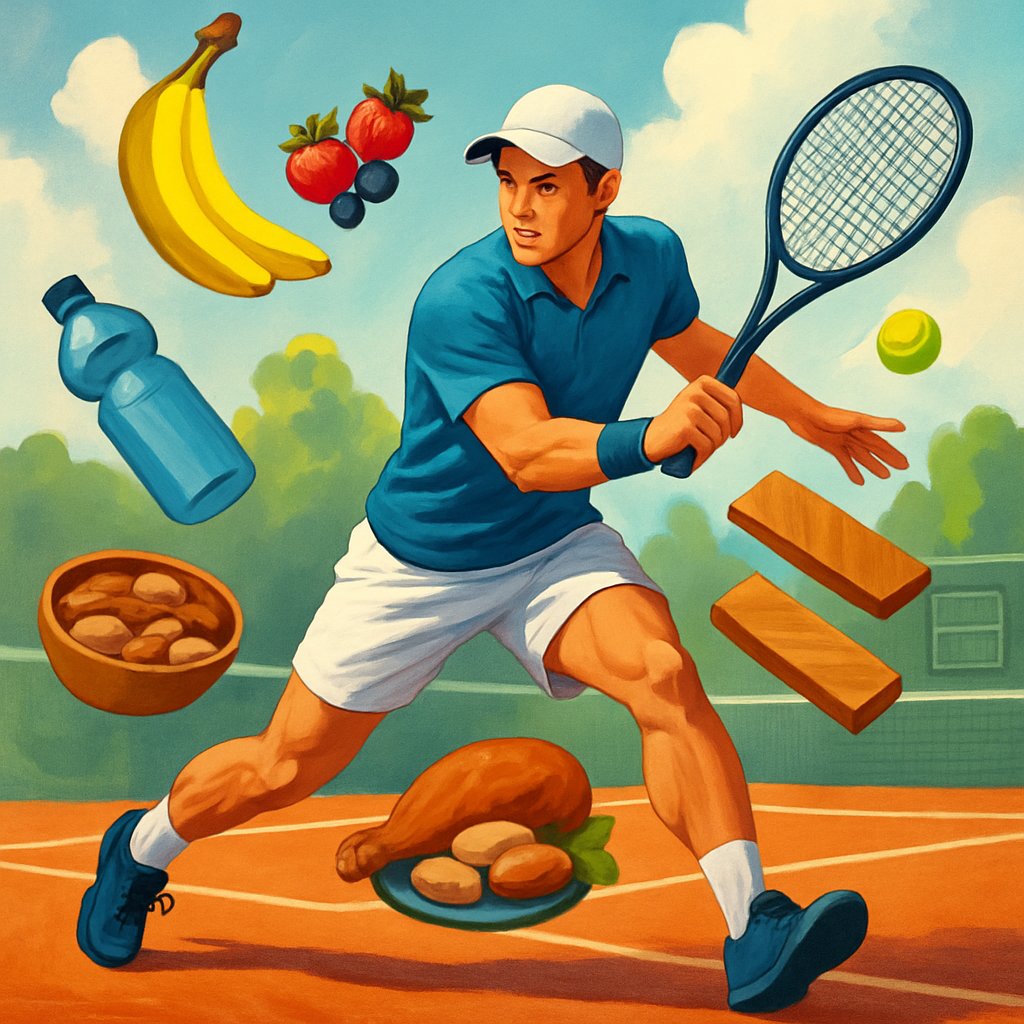
Tennis players always seem to have questions about nutrition timing, hydration, and what to eat for best results. Here are some practical answers for fueling up and recovering the right way.
What are the optimal pre-match foods to consume for high energy levels?
Eat a meal focused on carbs with a bit of protein about 3-4 hours before playing. That gives you time to digest and get steady energy.
Pasta with lean chicken, rice bowls with veggies, or oatmeal with banana and Greek yogurt all work well. They keep you fueled without upsetting your stomach.
Skip high-fat or high-fiber foods before matches. Those can slow you down or make you feel heavy on court.
Incorporate regular assessments to ensure your tennis nutrition strategies are effective and aligned with your goals.
How does hydration impact tennis performance, and what are the best practices?
Staying hydrated keeps your power, focus, and coordination sharp. Even a little dehydration can mess with your reactions and decision-making.
Start drinking water the day before your match. Sip throughout the day instead of chugging a lot at once.
During matches, aim for 4-6 ounces of fluid every 15-20 minutes. Water’s fine for matches under 90 minutes, but if you’re playing longer, go for a sports drink with electrolytes.
What should be the composition of a tennis player’s diet to ensure endurance and strength?
Try for 6-10 grams of carbs per kilogram of body weight daily. That keeps your muscle energy stores topped up.
Eat lean proteins like chicken, fish, eggs, or legumes for muscle repair. Shoot for 1.2-1.6 grams per kilo each day.
Fill half your plate with fruits and veggies at every meal. They bring vitamins, minerals, and antioxidants to help you recover and fight off illness.
How often should a tennis player eat during a tournament day?
Eat every 3-4 hours to keep your energy steady. That way you don’t crash between matches.
Understanding the importance of timing can enhance the effectiveness of your tennis nutrition strategies.
Have your main meal 3-4 hours before your first match. Snack on carbs every few hours to stay fueled.
Between matches, stick with easy-to-digest foods like bananas, energy bars, or toast with honey.
Are there specific nutrition recovery strategies for tennis athletes after intense matches?
Eat something within 30-60 minutes after your match. That’s when your muscles soak up nutrients fastest.
Go for a mix of carbs and protein. Chocolate milk, Greek yogurt with berries, or a turkey sandwich all hit the mark.
Don’t forget to rehydrate. Drink 16-24 ounces of fluid for every pound you lost during play.
Which supplements are safe and beneficial for competitive tennis players?
Most tennis players can get what they need from food. A balanced diet should come first, honestly—supplements are more of a backup.
Creatine might give you a little edge with those quick, explosive points. If you spend most of your training indoors, vitamin D can help keep your bones strong.
It’s always smart to check in with a sports nutritionist or doctor before you start taking anything new.
For competitive athletes, having a solid grasp of tennis nutrition strategies ensures optimal performance and recovery.
